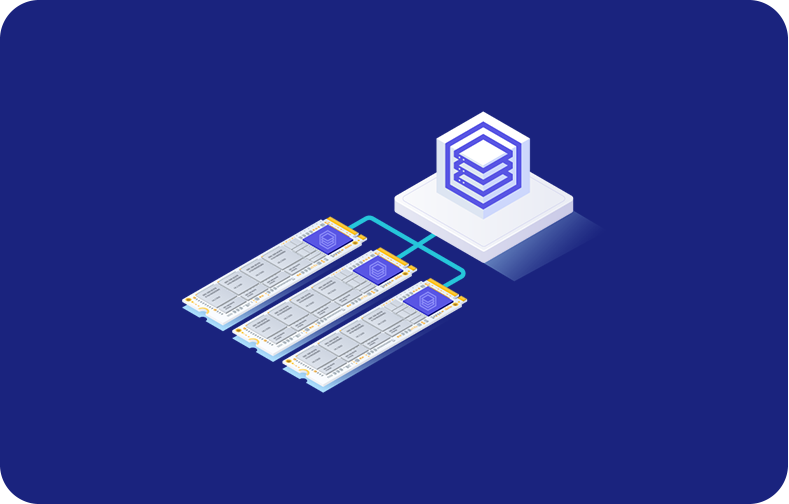Kubernetes: The Essential Guide to Managing and Scaling Containerized Workloads

Scale management of containerized applications can rapidly evolve into a significant challenge in this modern era. Although Docker containers facilitate the packaging of applications in a lightweight and portable manner, a robust utility is necessary to coordinate their deployment, scaling, and maintenance across numerous servers.
Kubernetes is an open-source platform that automates these jobs more easily and quickly. This article provides an in-depth analysis of Kubernetes, examining its fundamental features, advantages, and the reasons for its widespread adoption as the preferred solution for overseeing containerized deployments in contemporary cloud-native settings.
-
- What is Kubernetes?
- What Are the Benefits of Kubernetes?
- What Is Kubernetes Used For?
- How Kubernetes Works?
- Why Use Kubernetes?
- VPSServer Lets You Use the Full Power of Containerized Apps
Upon conclusion, you will possess an all-encompassing comprehension of how Kubernetes grants developers and operations teams the ability to construct, distribute, and oversee containerized applications that are both scalable and resilient.
What is Kubernetes?

Organizational adoption of containers has increased dramatically, and Kubernetes has emerged as the standard solution for containerized application management. Kubernetes originated from Borg, an internal system developed by Google, drawing upon its substantial experience of 15 years overseeing containerized applications.
Since its open-source release in 2014, Kubernetes has emerged as the prevailing standard in the industry, drawing upon the contributions of the open-source community and Google's extensive knowledge.
Kubernetes streamlines the process of deploying and managing applications in a manner that Borg directly influences. Automated container orchestration significantly reduces the time and resources necessary for daily operations while increasing dependability and productivity.
The integration of Google's expertise and the collaborative efforts of the community has solidified Kubernetes as the fundamental framework for deploying and administrating contemporary containerized applications.
What Are the Benefits of Kubernetes?

Kubernetes transforms containerized application administration by providing numerous benefits accelerating development, deployment, and continuing operations. Let's examine three significant advantages: automated operations, infrastructure abstraction, and service health monitoring.
Automated Operations
Managing containerized apps at scale can soon become a complex network of manual activities. Kubernetes faces this difficulty front on by automating critical operational tasks.
-
Deployment and Scaling: Avoid manually deploying or scaling individual containers between servers. Kubernetes handles everything. Define your desired application state using Deployment settings, and Kubernetes will spin up the necessary Pods (groups of containers) and scale them up or down based on predefined criteria. This ensures that your application scales automatically to meet changing resource demands.
-
Self-healing: Applications are not immune to failure. Kubernetes excels here by providing self-healing capabilities. It regularly checks the health of your Pods. If a Pod fails or crashes, Kubernetes restarts it immediately, ensuring your application stays operational even during unforeseen disruptions.
-
Rolling updates and rollbacks: Updating containerized applications has typically required downtime. Rolling updates from Kubernetes eliminate this pain point. It gradually replaces older container versions with newer ones within a Pod, reducing downtime and assuring a smooth transition. Furthermore, if an upgrade causes problems, Kubernetes allows you to smoothly roll back to a previous version.
These automated activities save development and operations teams time while significantly improving application stability and availability.
Infrastructure Abstraction
Serving as an abstraction layer between the containerized application and the underlying infrastructure is the function of Kubernetes. This decoupling provides various benefits:
-
Platform independence: When an application is independent, it can operate on bare metal servers, AWS or Azure clouds, hybrid systems, or even in the cloud. Kubernetes hides the complexity of the infrastructure below so that you can focus on your app's logic instead of the infrastructure's features. This helps with portability and makes multi-cloud setups easier.
-
Resource Management: As containerized applications become more complex, efficient resource utilization becomes essential. Kubernetes takes the lead here, automatically arranging Pods across available nodes (servers) based on resource needs. This guarantees that your infrastructure resources are used to their full potential and prevents resource bottlenecks.
-
Scalability: With Kubernetes, scaling your application is straightforward. Need to increase capacity? Simply add more nodes to your cluster. Kubernetes automatically discovers new resources and scales your application by deploying more Pods. This dynamic scalability enables you to deal with unforeseen traffic surges or application growth gracefully.
By abstracting the infrastructure layer, Kubernetes allows developers to focus on designing apps rather than worrying about infrastructure complexity. This flexibility enables enterprises to employ their existing infrastructure while efficiently maintaining seamless expansion capabilities.
Service Health Monitoring
Maintaining the health of your containerized application is critical. Kubernetes provides robust service health monitoring features to ensure your application works correctly.
-
Liveness and Readiness Probes: These are critical instruments for monitoring Pod health. Liveness probes determine whether a container is genuinely functioning and healthy. Readiness probes detect whether a Pod is ready to receive traffic. By configuring these probes, Kubernetes may automatically restart or prohibit sick pods from receiving traffic, ensuring application availability and responsiveness.
-
Monitoring Resource Consumption: Monitoring how resources are used to keep a cluster healthy is essential. Kubernetes monitors resource utilization (CPU, memory) at the pod and node levels. This lets you discover resource constraints and optimize the application or infrastructure setup.
-
Integration with Monitoring Tools: Kubernetes works flawlessly with popular monitoring tools like Prometheus and Grafana. This enables thorough monitoring of your cluster's health, including application performance indicators, resource use, and pod health status. Visualizing these metrics provides valuable insights into the general health of your application, allowing you to address possible issues ahead of time.
These health monitoring features enable development and operations teams to discover and resolve issues with their containerized applications proactively. This offers a pleasant user experience while reducing application downtime.

What Is Kubernetes Used For?
Due to its many uses, Kubernetes has become the platform of choice for handling containerized apps. Let's look at 3 main areas where Kubernetes shines: speeding up development, letting you launch in a variety of settings, and promoting quick and reliable service delivery.
1. Increasing Development Velocity
Rapid deployment and revision cycles are essential in the rapidly evolving realm of software development. Kubernetes streamlines this process by giving developers powerful tools:
Declarative Configuration
Streamlined configuration files and scripts are no longer necessary. Kubernetes implements a declarative methodology in which an application's intended state is specified through YAML files. This simplifies configuration management and minimizes errors. You tell Kubernetes what you want, and it handles the "how."
Delivery and Integration in A Continuous Fashion
CI/CD pipelines seamlessly integrate with Kubernetes, enabling developers to orchestrate the complete lifecycle of an application, including development, testing, deployment, and rollbacks. This automation allows developers to push changes regularly and confidently, increasing development velocity.
Blue/Green Deployments
Introducing new program versions might be dangerous. Kubernetes supports Blue/Green deployments, a secure and dependable means to provide new versions.
You launch the latest version alongside the previous one (blue) and gradually transfer traffic to it (green) while watching for any problems. If a problem emerges, you can easily roll back by redirecting traffic to the old version. This strategy reduces downtime and risk during implementation.
Kubernetes enables developers to focus on designing novel features and delivering applications more quickly by simplifying configuration management, connecting with CI/CD pipelines, and providing secure deployment options.
2. Deploy Applications Anywhere
Gone are the days when application deployment was limited to specific platforms or infrastructure. Kubernetes provides unequaled deployment flexibility.
Deployments Across Multiple and Hybrid Clouds
There is a growing trend among organizations to implement hybrid and multi-cloud environments. Kubernetes excels in these environments. A combination of on-premises and public cloud infrastructures may be utilized to deploy a containerized application. Kubernetes abstracts away the underlying complexities, enabling frictionless deployments regardless of the environment.
Bare Metal or Virtual Machines
Kubernetes' capabilities extend beyond container orchestration on cloud platforms. It can manage containerized apps on bare metal servers or virtual machines in your data center. This flexibility allows enterprises to use their existing infrastructure while reaping the benefits of containerization.
Edge Computing
The rise of edge computing opens up new opportunities for placing applications closer to data sources. Kubernetes can manage containerized applications operating on edge devices, allowing for real-time processing and faster response times in scenarios like IoT installations.
This deployment flexibility enables enterprises to select the appropriate infrastructure for their needs and effortlessly grow their applications across many environments.
3. Running Efficient and Reliable Services
At the heart of any successful application is efficient and dependable service delivery. Kubernetes gives the tools to ensure that your containerized applications execute smoothly.
High Availability
Downtime is detrimental to both the user experience and company continuity. Kubernetes ensures high availability by automatically resuming failed pods and scheduling them on available nodes. This redundancy protects your application from infrastructure outages, keeping it operational and responsive.
Load Balancing and Service Discovery
Managing traffic across several container instances can be challenging. Kubernetes simplifies this with Services. You create a Service object that serves as a virtual IP address for a group of pods.
Kubernetes automatically handles load balancing, distributing traffic across healthy Pods and guaranteeing optimal resource use. Furthermore, service discovery enables containerized applications to find and communicate with one another within the cluster quickly.
Resource Optimization
Efficient resource usage is critical for cost control and performance optimization. Kubernetes intelligently distributes pods between nodes depending on resource requirements.
Furthermore, technologies like horizontal pod autoscaling (HPA) allow for the automatic scaling of Pods based on resource use, ensuring that your application gets the resources it requires while avoiding over-provisioning.
Kubernetes enables you to provide your consumers with stable and performant containerized services by assuring high availability, effective load balancing, and optimum resource allocation.
How Kubernetes Works?
Kubernetes, a prominent open-source platform, has thoroughly transformed the management of Kubernetes containerized applications. But how does it organize these applications over a Kubernetes cluster? Here's a breakdown of the core components and how they interact:
The Kubernetes control plane
Responsible for issuing commands and preserving the cluster's intended state, the control plane functions as the cluster's intelligence. It is made up of a few main components:
-
Kubernetes API Server: This central component is the entry point for all cluster-related communications. The Kubernetes API enables tools and administrators (preferably certified Kubernetes administrators) to utilize configuration files or execute commands to interact with the cluster. The API server validates requests, communicates with other control plane components, and sends directives to govern containerized applications.
-
etcd: This highly accessible key-value store serves as the cluster's primary source of truth. It contains all cluster configuration information, including the desired state of pods, services, and other resources. The control plane components rely on etcd to retrieve and update essential data.
-
Kubernetes Scheduler: The scheduler regularly analyzes the cluster's status and resource availability. When a new Pod needs to be deployed, the scheduler chooses the most appropriate node in the cluster based on predefined rules and resource requirements. This ensures that containerized programs use their resources efficiently and perform optimally.
-
Kubernetes Controller Manager: This component maintains several controllers that regularly reconcile the cluster's current state with the desired state provided in the API server. These controllers include Deployment controllers, which guarantee that Pods run as expected, and ReplicaSet controllers, which keep the desired number of Pod replicas within a Deployment.
Worker Nodes and Container Runtime
Worker nodes are the heart of a Kubernetes cluster. These standalone devices (physical servers or virtual machines) run containerized applications. Every node has a container runtime installed, such as Docker or containers. The container runtime manages the lifecycle of individual containers within a pod.
The control plane connects with worker nodes through an agent known as the kubelet. The kubelet receives control plane directives, such as initiating, stopping, or restarting Pods. It then communicates with the container runtime to perform these commands on the worker node.
Kubernetes Service and Networking
-
Kubernetes Services: These abstraction layers give a consistent network identity for a collection of pods. They serve as virtual endpoints that allow apps to discover and communicate with one another. Services can be set up using various load-balancing techniques to distribute traffic efficiently across healthy pods in the cluster.
-
Kubernetes Networking: The Kubernetes networking model guarantees seamless communication between Pods within a cluster. This is accomplished by utilizing network modules with the CNI (Container Network Interface) standard. Network plugins such as Flannel and Weave Net configure the cluster's underlying architecture.
The Kubernetes Ecosystem
The vibrant Kubernetes ecosystem provides a wide range of Kubernetes resources, tools, and extensions that improve the capabilities of Kubernetes clusters. These tools can be utilized for:
-
Container Image Management: Docker Hub and private container registries can be connected with Kubernetes to manage the lifecycle of your application's container images.
-
Monitoring and Logging: Integrating technologies such as Prometheus and Grafana enables detailed tracking of cluster health, application performance, and resource use.
-
Configuration Management: Tools like Helm make deploying and managing complicated applications easier by storing configuration files and deployments as reusable packages (Helm charts).
Why Use Kubernetes?
In the world of containerized apps, efficient management and orchestration are critical. This is where Kubernetes stands out as the undisputed champion. But what drives enterprises to choose this open-source platform (created by the Linux Foundation)? Let's look at the compelling reasons why Kubernetes stands out.
1. Make Workloads Portable
Application deployment is no longer limited to specific platforms or infrastructure. Kubernetes enables you to deploy Kubernetes across multiple environments with unprecedented flexibility:
Hybrid and Multi-Cloud Deployments
The cloud landscape is progressively adopting hybrid and multi-cloud techniques. Kubernetes excels in these environments. Containerized applications can be administered without interruption across a hybrid environment comprising on-premises infrastructure, public clouds such as AWS or Azure, or both.
Kubernetes serves as an abstraction layer, separating your applications from their underlying infrastructure and providing portability. This enables enterprises to use their existing infrastructure best while implementing cloud-native technologies without being locked into a specific vendor.
Hardware or Software-Based Systems
Kubernetes' capabilities extend beyond container orchestration on cloud platforms. It can successfully manage containerized applications running on bare metal servers or virtual machines in your data center. This flexibility enables enterprises to capitalize on their existing infrastructure investments while reaping the benefits of containerization and a modern development strategy.
By offering this level of mobility, Kubernetes future-proofs your deployments and lets you select the infrastructure that best meets your changing requirements.
2. Scale Containers Easily
Managing the growth of containerized apps can be challenging. Kubernetes addresses this difficulty front-on by providing seamless scaling capabilities:
Horizontal Pod Auto-Scaling (HPA)
This feature allows your Kubernetes environment to automatically scale Pods (groups of containers) based on predefined parameters such as CPU or memory use.
HPA dynamically modifies the number of deployed containers, ensuring your application has the resources to handle variable workloads. This eliminates manual intervention while ensuring peak performance during traffic surges or application expansion.
Load Balancing and Service Discovery
Kubernetes streamlines traffic management across several deployed containers. Kubernetes Services serve as virtual IP addresses for a group of pods, allowing for effective load balancing. Incoming traffic is automatically dispersed across healthy Pods in the cluster, guaranteeing optimal resource use and avoiding bottlenecks.
Furthermore, service discovery enables containerized apps to quickly find and communicate with one another within the cluster, regardless of the underlying infrastructure or the number of deployed container instances.
Kubernetes enables you to construct robust apps capable of handling unpredictable traffic patterns by providing straightforward scaling features. This leads to a better user experience and reduces the likelihood of application downtime during peak demand periods.
3. Create More Extensible Apps
Modern applications are frequently complicated, consisting of multiple microservices. Kubernetes lays the groundwork for creating highly extendable and maintainable applications:
Declarative Configuration
Say goodbye to cumbersome configuration files and programs. Kubernetes has a declarative approach, allowing you to declare the desired state of your application via YAML files. This streamlines configuration management lowers errors and allows a trained Kubernetes administrator to manage complex deployments easily.
Kubernetes Operators
These are application-specific controllers that augment Kubernetes' capabilities and make it easier to manage complex applications. Operators can automate application deployment, configuration, and lifecycle management operations in the Kubernetes environment.
This allows development teams to focus on creating innovative features while reducing the operational strain associated with administering complex applications.
Central Log Storage System and Monitoring
Monitoring the health and performance of containerized applications running across numerous containers can be difficult. Kubernetes works well with popular monitoring tools like Prometheus and Grafana.
These tools enable you to collect and analyze logs from various cluster components, such as deployed containers, the Kubernetes control plane, and network traffic. This unified logging and monitoring enables development and operations teams to proactively detect and resolve issues, ensuring your applications run smoothly.
By providing a solid framework for managing complicated deployments, declarative configuration options, and integration with powerful monitoring tools, Kubernetes enables you to create highly scalable and maintainable applications that match the demands of today's dynamic IT landscape.
VPSServer Lets You Use the Full Power of Containerized Apps
We at VPSServer recognize the increasing demand for containerized solutions. That's why we provide a variety of pre-configured Kubernetes service images, allowing you to deploy and manage your containerized apps easily.
Visit VPSServer now to experience the benefits of Kubernetes. Explore our Kubernetes service images and learn how our high-performance 100% SSD VPS hosting can be the perfect basis for your containerized applications. Our specialized support team is also accessible to answer any questions.
Conclusion
This all-encompassing article has revealed the capabilities of Kubernetes, the top management platform for containerized applications. Kubernetes provides unparalleled scalability, flexibility, and robust administration functionalities, enabling the development and deployment of contemporary, resilient applications that flourish in the ever-changing IT environment of today.
Frequently Asked Questions
What makes a certified Kubernetes administrator?
A certified Kubernetes administrator has proven the ability to perform basic installation, configuration, and management of production-grade Kubernetes clusters.
How does CNCF certification work?
For IT workers who are interested in Kubernetes and cloud-native abilities, cloud native computing foundation certifications are ideal. These include comprehension of the fundamentals of cloud-native security and practical experience with projects related to storage, networks, GitOps, and service mesh.
What are some common use cases for Kubernetes?
Kubernetes is used to deploy, scale, and run application containers across clusters of servers. It automates and scales modern, cloud-native applications by deploying microservices, managing batch and large data workloads, and easing CI/CD pipelines.












